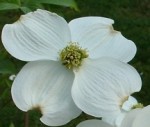 A native of eastern US, flowering dogwood is a small deciduous tree beloved for the white flowers that cover the tree in spring. Botanically, however, the flowers are actually greenish and very small but are produced in clusters and surrounded by four white, notched petal-like bracts. The over-all effect is a white flower about three to four inches across. A variety, rubra, has pink bracts. Clusters of small red berries attractive to wildlife follow in late summer and persist into fall. The simple, entire, oval leaves are 3 to 6 inches long and 2.5 to 4 inches wide with sharply pointed tips. They appear rosy green when they appear in the spring turning bright to dark green in summer and then red in the fall. The tree is low branching with the branches arranged in horizontal tiers and the medium brown bark is checkered. A popular choice as a specimen tree or planted in small clusters especially on woodland edges. The generic name Cornus. coms from the Latin word cornus meaning horn and may refer to the strength of the wood. The specific name, florida, comes from the Latin word,flos, meaning flower.
A native of eastern US, flowering dogwood is a small deciduous tree beloved for the white flowers that cover the tree in spring. Botanically, however, the flowers are actually greenish and very small but are produced in clusters and surrounded by four white, notched petal-like bracts. The over-all effect is a white flower about three to four inches across. A variety, rubra, has pink bracts. Clusters of small red berries attractive to wildlife follow in late summer and persist into fall. The simple, entire, oval leaves are 3 to 6 inches long and 2.5 to 4 inches wide with sharply pointed tips. They appear rosy green when they appear in the spring turning bright to dark green in summer and then red in the fall. The tree is low branching with the branches arranged in horizontal tiers and the medium brown bark is checkered. A popular choice as a specimen tree or planted in small clusters especially on woodland edges. The generic name Cornus. coms from the Latin word cornus meaning horn and may refer to the strength of the wood. The specific name, florida, comes from the Latin word,flos, meaning flower.
Type: Flowering deciduous tree
Outstanding Feature: Flowers, fruit, fall color
Form: Flat topped; low horizontal branching
Growth Rate: Medium
Bloom: Small greenish flowers surrounded by four showy white, notched bracts, in spring
Size: 10-30 ‘ H x 15-30’ W
Light: Partial shade but tolerates sun and shade.
Soil: Average, moist, well-drained; tolerates acid soil.
Hardiness: Zones 5-9
Care: Prune in winter as little as possible to maintain shape; flowers produced on new growth; mulch to keep roots cool.
Pests and Diseases: Anthracose, powdery mildew, leaf spot, canker, root rot, leaf and twig blight, trips, borers; stressed plants are likely to have problems.